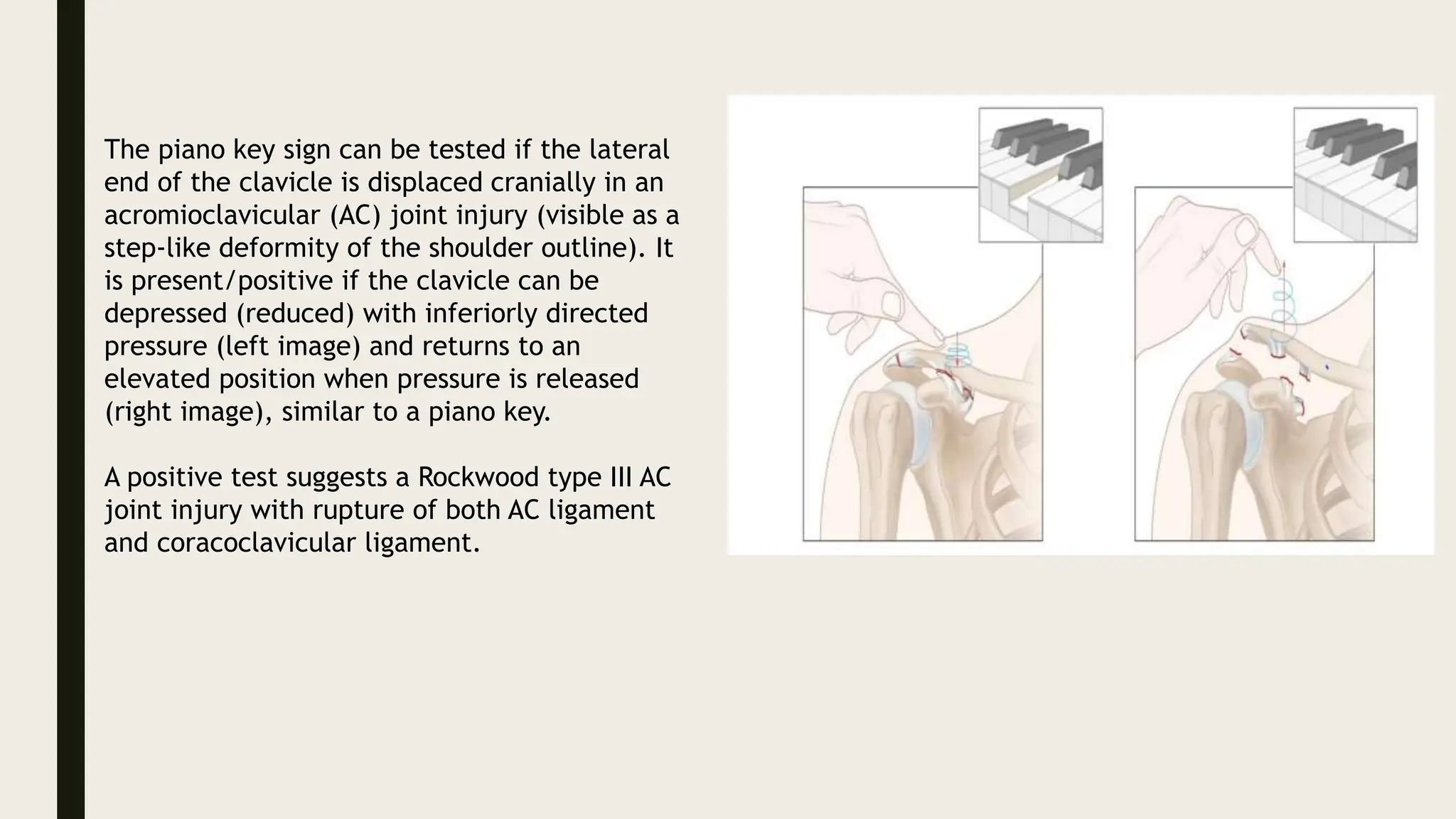The document discusses various upper extremity injuries including acromioclavicular joint injuries, elbow dislocations, and forearm fractures. It describes the typical mechanisms of injury, clinical features, classifications, diagnostic assessments including x-rays, and treatment approaches for acute management such as splinting or surgery. Elbow dislocations can be posterior, anterior, medial or lateral and are often caused by falls on an outstretched hand. Forearm fractures require a full neurovascular examination and imaging to guide specific fracture treatment.















![■ Diagnostics
■ Physical examination
■ Signs of fracture
■ Neurovascular deficits
■ X-ray of the elbow joint: anteroposterior and lateral views to confirm dislocation
and exclude fracture
■ Posterior fat pad sign: seen in patients with concomitant fractures (usually of the
humerus/radial head) [4]
■ Radiocapitellar line
■ On a lateral x-ray of the elbow joint, an imaginary line drawn through the center
of the neck of the radius should pass through the center of the capitellum of the
humerus.
■ If an elbow dislocation is present, the line does not intersect the capitellum.
■ CT scan of the elbow joint: indicated only if a complex elbow dislocation is
suspected to evaluate the extent of associated fractures](https://image.slidesharecdn.com/vyshnavimalladiupperextremitiesinjury-240217073103-d2850f5b/75/Upper-Extremities-injury-pptx-16-2048.jpg)





![Forearm Fractures
■ Initial management
■ The following are indicated irrespective of the fracture type and bones involved:
[3][2]
■
■ Perform neurovascular exam.
■ Assess radial and ulnar artery pulses and capillary refill time.
■ Evaluate for median nerve injury , radial nerve injury , and ulnar nerve injury.
■ Consider indications for orthopedic consultation for fractures.
■ Obtain imaging of the forearm and consider adding imaging of the elbow and wrist to
check for associated injuries.
■ Evaluate for signs of compartment syndrome in any patient with high-energy impact
trauma.
■ Provide analgesia for acute fractures.
■ Continue with management specific to the injury identified on imaging, e.g., complete
forearm fracture, Monteggia fracture, Galeazzi fracture](https://image.slidesharecdn.com/vyshnavimalladiupperextremitiesinjury-240217073103-d2850f5b/75/Upper-Extremities-injury-pptx-22-2048.jpg)


![Complete forearm fractures
■ Definition: fracture of both the radial shaft and ulnar shaft
■ Epidemiology: more common in children [2]
■ Etiology: FOOSH injury (common in children), high-energy trauma (e.g., MVC)
[2]
■ Clinical features [2]
■ Pain and swelling of the mid-forearm
■ Gross deformity
■ Nerve injury is uncommon with closed fractures.
■ Diagnostics: x-ray [2][5]
■ May show nondisplaced, displaced, or greenstick fractures of both shafts of
the radius and ulna
■ Injury from high-energy trauma: may show angulation > 10° and/or](https://image.slidesharecdn.com/vyshnavimalladiupperextremitiesinjury-240217073103-d2850f5b/75/Upper-Extremities-injury-pptx-25-2048.jpg)



![■ Monteggia fracture
■ Definition: proximal (or middle) ulnar fracture with concomitant dislocation of
the radial head
■ Etiology
■ Fall on outstretched and pronated forearm (low-energy trauma)
■ Direct blow to the forearm, high-energy trauma (e.g., MVC)
■ Clinical features [2][5]
■ Pain, crepitus, and limited range of motion at the elbow
■ Radial head palpable in antecubital fossa Shortened forearm
■ Posterior interosseous nerve injury can occur. Paresthesias to the dorsal
aspects of the thumb, second, and third fingers
■ Loss of thumb extension](https://image.slidesharecdn.com/vyshnavimalladiupperextremitiesinjury-240217073103-d2850f5b/75/Upper-Extremities-injury-pptx-29-2048.jpg)

![■ Diagnostics:
■ x-ray [2]
■ Shows a fracture of the proximal (or middle) ulna with dislocation of the radial
head (dislocation can be anterior, posterior, or lateral)
■ Lateral view: The radiocapitellar line does not intersect the middle of the
capitellum, suggesting elbow dislocation.
■ Treatment Begin general management of forearm fractures. [2]
■ Children with uncomplicated fractures: Closed reduction by an orthopedic
surgeon is often successful.
■ Adults and patients with complicated fractures
■ Initial: Immobilize in a posterior long arm splint.
■ Definitive: ORIF (e.g., plating, K-wire fixation) required for most injuries
■ Disposition: Consult orthopedics urgently.](https://image.slidesharecdn.com/vyshnavimalladiupperextremitiesinjury-240217073103-d2850f5b/75/Upper-Extremities-injury-pptx-31-2048.jpg)
![■ Radial head fracture
■ Definition: fracture of the radial head
■ Epidemiology: more common in adults than radial head subluxation or dislocation [8]
■ Etiology
■ FOOSH with the elbow partially flexed and pronated [9]
■ Stress fracture (e.g., in throwing sports)
■ Clinical evaluation [9]
■ Perform a neurovascular exam. [10]
■ Radial head region is tender to touch.
■ Pronation and supination of the forearm are painful.
■ Effusion or hemarthrosis of the elbow joint may be present.](https://image.slidesharecdn.com/vyshnavimalladiupperextremitiesinjury-240217073103-d2850f5b/75/Upper-Extremities-injury-pptx-32-2048.jpg)
![■ Diagnostics: x-ray elbow (AP, lateral and oblique) [3][9][10]
■ Fracture through the radial head is not always visible.Evidence of effusion (sail
sign and/or posterior fat pad sign) may be the only finding.
■ Comminuted fractures: Consider imaging the wrist, as these fractures may be
associated with additional injuries. [10]
■ Treatment: Begin general management of forearm fractures.Fractures with >
60 degrees of angulation often require open reduction and orthopedic consult. [3]
■ Nondisplaced fractures: conservative treatment
■ Immobilize in a sling or posterior long arm splint for 24–72 hours. [3][11]
■ Start early ROM exercises.
■ Complex fractures: typically surgical treatment
■ Pain management
■ Consider hemarthrosis aspiration only as an adjunct to splinting in select patients.
■ Avoid intraarticular local anesthetic infiltration.
■ Disposition: typically outpatient management with short-term orthopedic follow-
up
■ Complication: cubitus valgus](https://image.slidesharecdn.com/vyshnavimalladiupperextremitiesinjury-240217073103-d2850f5b/75/Upper-Extremities-injury-pptx-33-2048.jpg)

